By Chris Roth

Fir Ridge founder (not really) during happier days.
I was part of several groups in which the generational torch was not so much “passed” as “seized.” Circumstances, motives, strategies, and
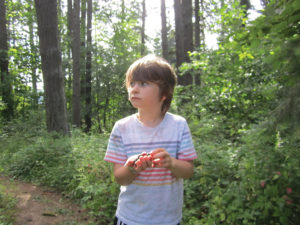
Fir Ridge founder (not really) developing love of wild edibles as youth.
outcomes varied, but in each instance this process of torch-passing-under-duress involved both collateral damage and transformation.
In one case, the younger group’s actions seemed part of a necessary reinvigoration, the only way of escaping deepening ruts and a continuing descent into communal oblivion. In another, quite different case, the torch seizure itself almost led to communal oblivion.
● ● ●
Fir Ridge community (not its actual name) benefited from the clear vision of its charismatic, quite assertive leader―until it didn’t. In fact, conflicts had apparently commenced almost immediately upon the group’s pre-communal founding (as a 501(c)(3) nonprofit with a public mission), and by the time of my arrival, five years into the project’s land-based phase, a full-blown case of founder’s syndrome had already developed, with only the founder, his partner, and one close ally remaining from the early years.
From my perspective as a 24-year-old joining my first residential intentional community, Fir Ridge had existed nearly forever on this land, so well-established did its culture and hierarchies seem upon my arrival. The five additional years that passed before the board served an eviction notice on the founder, and the additional year-and-a-half consumed by legal proceedings and his court-mandated exit, would seem almost like an eternity―not only to me, but to those who struggled through the difficult dynamics during that time.
In the years preceding the eviction notice, waves of people arrived and left, some of them openly rebelling, and many of them reporting feeling

Fir Ridge founder (not really) trying to retrieve his swimming trunks with stick, not carrotâa taste of things to come.
that the work they did for the group, the projects they proposed, and their own identities as human beings were being disrespected, invalidated, shut down by a founder who could not tolerate any vision different from his own, or any accomplishment that bore someone else’s stamp, or any person who did not seem to serve his own goals. Initially drawn by the strength of his vision and the force of his personality, they eventually found that they had surrendered, or he had taken, too much of their own power for comfort.
As long-term friends and supporters of the group came to recognize the patterns besetting it, they attempted a series of interventions with the aim of preserving the community and his participation in it. These included a coastal retreat in which, in a relaxed setting, some of his closest friends and strongest “believers” from the immediate and extended community tried to convey to him the gravity of the situation and the necessity for some changes in communication style and behavior if the project and his part in it were to have a chance to survive. They offered open hearts and listening ears to hear about the difficulties he himself must be experiencing. They offered whatever support he might ask for in navigating the changes they were counseling. They emphasized how important they felt it was to have open conversations about community members’ concerns, and to listen to one another in a supportive setting, in order to transform the dysfunctional patterns and power dynamics that seemed to be making not only others, but the founder himself, miserable.
Unfortunately, he would have none of it. Nor did he respond positively to other attempts to resolve difficulties before they became crippling to

Fir Ridge founder (not really) becoming a target, early on, for those who dislike gardening.
the group and ultimately to himself. After the failure of many attempts to find an alternative which would allow him and others to live and work together harmoniously, the governing nonprofit’s board of directors concluded that no viable future existed with the founder still living on site.
Predictably, the founder did “not go gentle into that good night,” and raged, raged against the dying of the light he’d been carrying for the group. He mistook the eviction-notice-posting board member’s ponytail for a bell lanyard (a costly mistake, it turned out, once the incident reached civil court), he mistook a coterie of his most ardent supporters for the full membership of the organization (in a hastily and secretly convened “membership meeting” to which only they were invited), he mistook the group of people they elected as their “board” for the actual board of directors, he mistook $50,000 that had been given early on for the purchase of the land for $50,000 that could be retained in the nonprofit’s bank account only if he were guaranteed a position as lifetime steward of the land, and must therefore be returned in the interim to the granting organization in another country. And, with only a few people remaining on site after these developments, he mistook the rest of the recent residents, as well as the wider membership of the organization, including many others who had left over the years, for a group that would go gentle into that good night, that would “move on” as all previous configurations seemed to have done after trying unsuccessfully to make changes in the group.
He also mistook the lawyer he and his supporters hired (to force the legitimate board of directors to resign under threat of lawsuit, which they were certain to do since they were no longer backed by any money in the organizational bank account) for a more competent, more clever lawyer than he turned out to be. And he mistook the lawyer hired by supporters of the legitimate board for a lawyer less competent, less clever than his own. He mistook the legitimate board members for people who would not think to appoint successors as they resigned (with his lawyer not anticipating this possibility and therefore not present at the meeting), and he mistook two of his former-friends-turned-nemeses for people who would not report a $50,000 theft of organizational funds to the State Attorney General, as they duly did upon becoming the new legitimate board members.
It is never easy to sit in courtroom opposite a few people who used to be one’s community-mates, but it is easier when at least 10 times as

Fir Ridge founder (not really) preparing to push tree onto Maple Creek founder (not really) and friend.
many former community-mates and community-friends sit on one’s own side of the aisle as on the other. And it is also reassuring to hear, from one’s crowdfunded lawyer, that the judge has told the other side’s lawyer, in response to his arguments on behalf of his clients, “Not to put too fine an edge on it, but it’s springtime, you’re on thin ice, and the ice is melting.”
Having lost the case, the founder negotiated a several-month period of packing up and exiting the site. (By that time, he had barricaded himself behind a locked entrance gate with his partner and one intern, who, no doubt, was initially as thrilled as many of us had been by the chance to make a difference in a mysteriously depopulated place with so much potential and with such a visionary, charismatic leader.) The departure of the founder and his companions cleared the way for the new crew (some of whom had also been the old crew, before their departures) to return in the spring and pick up the still-flickering torch. The efforts of many had prevented it from being snuffed out entirely in hands gripping too tightly, no longer able to carry it alone but also unwilling or unable of their own accord to share it or pass it on.
This was not the end of the story at Fir Ridge, and not everything became “better” after this torch-passing. Some of those newly empowered

Fir Ridge founder (not really) falling prey to macho culture as Maple Creek founder (not really) and friend look on.
seemed prone to the “baby with the bathwater” phenomenon, rejecting strict adherence to the group’s traditional practices and worldview simply because these choices and values (such as prioritizing seasonal, organic, homegrown foods, avoiding new, industrially-produced building materials, aspiring to be a group of planetary citizens first, rather than just a more eco-friendly version of mainstream America) had been associated with the founder and his strong vision. Moreover, the cautionary words of one board member who’d resigned rather than sign his name to the eviction notice―“If you get rid of the top rooster in the coop, another rooster will just take his place”―sometimes seemed prescient, although recurring problems with hierarchy and power never again required an eviction notice to help solve them. In fact, several “golden ages” followed during which power was much more equally distributed and both morale and mission-fulfillment were high.
After the group’s memorable and troubled first decade on the land, a complete collapse had seemed likely without significant positive change. Fortunately for Fir Ridge, the subsequent “seizure of the torch” opened up the opportunity for that change―which happened in various ways, in large and small increments, and occasionally in reverse, and is still ongoing more than 25 years after the rumors of the place’s death first turned out to be greatly exaggerated.
● ● ●
Maple Creek community (also not its actual name) experienced its own “seizure of the torch” from the founding generation, though almost
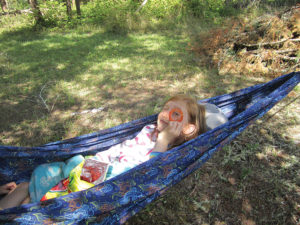
Maple Creek founder (not really) discovering and celebrating hole-ism.
every detail and nuance was different in this case from that of Fir Ridge. Maple Creek’s founder had a much quieter, more subtle charisma, and while not afraid of being outspoken when the topic seemed to merit it, was perhaps more prone to err on the side of not being assertive enough rather than too assertive. Having seen the initiators of other communities fall victim to founder’s syndrome, she took many steps to try to avoid that fate, including often refraining from commenting on or objecting to plans that would not have been her first choice. She was conscious that her own words could carry extra weight in others’ perceptions, and wanted to be sure other community members felt empowered, rather than oppressed by her seniority.
Maple Creek was always more egalitarian than Fir Ridge, with a distributed leadership structure from the outset, and a high value placed on full consensus. (By contrast, at Fir Ridge, the group’s process of “consensus-minus-one” often proved a vehicle for the founder and his partner to marginalize outliers and always get their way―something also reliably accomplished, when the first tactic didn’t work, by storming out of meetings, since everyone knew that nothing could happen without the founder’s buy-in.) Maple Creek’s group process, honed over many years and aided by weekly group well-being meetings and various shared personal growth and compassionate communication practices, became a success story in the communities world, featured in a well-known book about creating successful communities and even (with some humorous inaccuracies and exaggerations resulting from different ways of interpreting and translating the word “love”) in the French edition of Rolling Stone.
Though she was the sole remaining original community member (turnover was high early on), the founder for many years functioned as an equal peer to other influential members in the community. Had she held the “founder” reins too tightly rather than inviting in new energy and initiative, the group would have collapsed within a year or two of its founding, as physical and economic conditions on the site were quite challenging at first. As a result, those who came and found useful roles in the community generally felt empowered rather than oppressed―no one had power over anyone else. The founder’s experience and perspective were valued, but did not overrule those of others―nor was there much occasion for this to happen. The group that I joined (in my mid-30s this time) was remarkably unified, partly through respect for one another’s diversity and partly by shared values and practices. Everyone had a valuable and valued role, whether that was in managing events or in coordinating childcare, gardening or doing maintenance, teaching or leading cleaning parties. It was, in many ways, a community of leaders.
For various reasons, over time, different members of the group that had been so unified left the community―usually not from an onset of
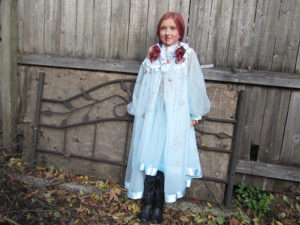
Maple Creek founder (not really) recognizing that life can be bloody difficult.
“Maple Creek fatigue” but because family, career, or transportation difficulties (e.g., shuttling growing children to and from activities in town) led them away. Those who arrived to take their places had not been part of this community history, and perhaps had never experienced the kind of shared power and group connection that distinguished Maple Creek’s “golden age.” Often, they came from backgrounds in hierarchical institutions, and were accustomed to there being authorities who needed confronting, rebelling against, or replacing.
The founder continued to try to avoid being perceived as more powerful or influential than anyone else, and spent significant amounts of time on travels away from the community, reinforcing the impression that her hands-off approach was a genuine, conscious choice. At the same time, ironically, her most strongly held values had to do with consensus, connection, and shared power―the elements of community culture and governance that had kept it from being taken over or dominated by the power-hungry or by anyone else, whether they be founders, “experts,” elders, the young, the wealthy, or the unusually charismatic. These same fundamental community values seemed to be increasingly under threat within the group.
In the perfect storm that followed, some newer arrivals viewed the founder’s advocacy for egalitarian principles as a roadblock to their aspirations and a threat to their views of how a group should be structured. The founder felt equally strongly that the community’s culture was worth preserving. Yet that culture depended on community buy-in, and many of those who shared that cultural view with the founder had either left or did not assert themselves well in an increasingly conventional, competitive governance environment.
A newer resident who’d been a government bureaucrat believed that the membership process, including the visitor weeks organized and led by the founder, was deeply flawed, and successfully lobbied the group for its suspension while he designed something “better” (this decision was made easier by the fact that the community was already full with residents, and even had a waiting list, so couldn’t accept anyone new into the membership process anyway). A newer resident with legal background critiqued the community’s culture of transparency, and believed that most community members were not qualified to make decisions about legal or financial matters; she successfully pushed a resolution to make the board of directors self-electing rather than elected by the full group of members. A newer resident with aversion to personal growth work, joined by others for whom this was also new territory, lobbied against continuing the personal growth workshops we’d been hosting. And a group of those pursuing new visions for how the group would operate decided that the founder needed to be disinvited from participation in some of their processes, in order for them to feel as if they had free rein.
Some who especially valued the founder, her contributions, and the cultural elements she upheld were deeply disappointed by these
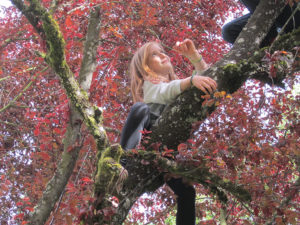
Maple Creek founder (not really) developing the first tenets of her eco-spirituality.
developments. She was the sole remaining member of her generation within the community, and a particular inspiration for younger members who felt attuned with and hungry for the earth-based spirituality, ecofeminism, and elder Crone wisdom she embodied. Eventually, given the prevailing tide, most of those who appreciated her and what she stood for left the community, as did she, to give her energy in places where it was clearly valued rather than seen as a threat by some.
The new generation who emerged victorious from this “coup,” now holding the torch that they imagined they’d wrestled from her (in fact, I believe she was a stand-in for the more cooperative, open culture that she’d been part of manifesting in the group), unfortunately did not know how to hold it. Despite any contradictory impressions that this condensed retelling may suggest, her sidelining and departure had actually happened “not with a bang, but a whimper,” and this is how the wick of the new group’s visions burned out too.
The ex-bureaucrat never did complete a draft of his new membership plan, and the community was left without a membership process to use once it had openings again (as quickly happened once these changes commenced). Decision-making became increasingly secretive within a closed group, and trust and morale within the community as a whole sank. Without the presence of personal growth workshops or those who’d considered them most important, the group culture reverted to one of more personal stagnation and interpersonal distance and tension, sometimes erupting into terrible conflicts that were never resolved. And without the presence of the community’s founder and elder, many in the wider neighborhood and community were left feeling disconnected from Maple Creek, puzzled by what the group had become, disconcerted by the disintegration of a culture that had once so inspired them.
Soon thereafter, I left too. Within two years of the founder’s departure, all of those newer members who’d precipitated these changes had
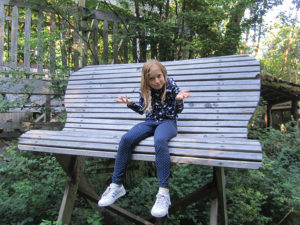
Maple Creek founder (not really) learning that she is small in relation to the universe.
decided to do something different with their lives and departed as well. Yet, miraculously, the torch they’d seized still burned, rescued from extinction by some other friends of the community who’d seen its promise.
In subsequent years, this newly arriving, multi-generational group was largely able to resuscitate, restore, and even expand upon that promise, despite the predictable and unpredictable setbacks that confront every community.
How that came to pass is another story for another issue: hopefully the next one (#186, Picking Up the Pieces: New Beginnings). Additional cases of torch-seizure, torch-rescue, and collapse and rebirth rather than smooth transitions will feature in that issue too. At the risk of breaking the fourth-and-three-quarters wall separating author, editor, and reader: please join us then!
Chris Roth edits Communities.
Excerpted from the Winter 2019 edition of Communities (#185), “Passing the Torch: Generational Shifts in Community.”
